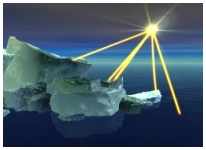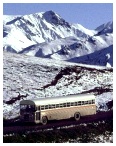
 It's that black dirty soot! When polar icecaps start to melt, less sunlight gets reflected back into space. Temperatures start to rise as more sunlight gets absorbed into the oceans and land, and this causes even further melting. We all know that dark things absorb more light and heat than light things (white clothing in summer, dark clothing in winter). Dark-colored black carbon, or soot, absorbs sunlight, so soot-covered ice reflects less light as well. It's changing the way sunlight reflects off snow and ice.
When soot covered snow and ice begins melting, the warming effect increases - the layers of soot become more concentrated on the snow surface. As glaciers and ice sheets melt, they get even dirtier! And who are the big offenders? The soot comes mostly from diesel engines, including the diesel-powered tour buses (Picture: right) like the ones that travel the roads through tourist destinations such as Denali National Park in Alaska.
Click pictures for more information and credits. Library: Ice, Snow, Land Environment/Atmosphere, Arctic Links: Environment, Arctic News Story: Warning Signs in the Arctic Arctic Maps & Weather Reports |

|
DICTIONARY: Just "double-click" any unlinked word on this page for the definition from Merriam-Webster's Student Electronic Dictionary at Word Central. |

|
ARCTIC LIBRARY & GLOSSARY: Check this section for an index of the rest of the things you really need to know about the Arctic. |

|
ARCTIC MAPS & WEATHER REPORTS: Maps of the Northwest Passage, explorers' routes, iceberg sources, Nunavut, the Arctic by treeline, temperature... |

|
ARCTIC LINKS: Even more information! Links to sites related to the Arctic and "Iceberg: the Story of the Throps and the Squallhoots". |

|
GUIDE TO ARCTIC SUNRISE & SUNSET: How much sunlight or darkness is there in the Arctic on each day of the year? |
to is the property of their respective owners, and Athropolis is not responsible for their content.
